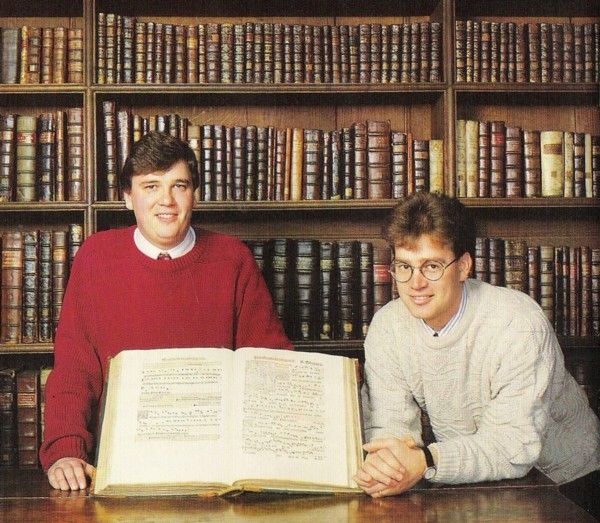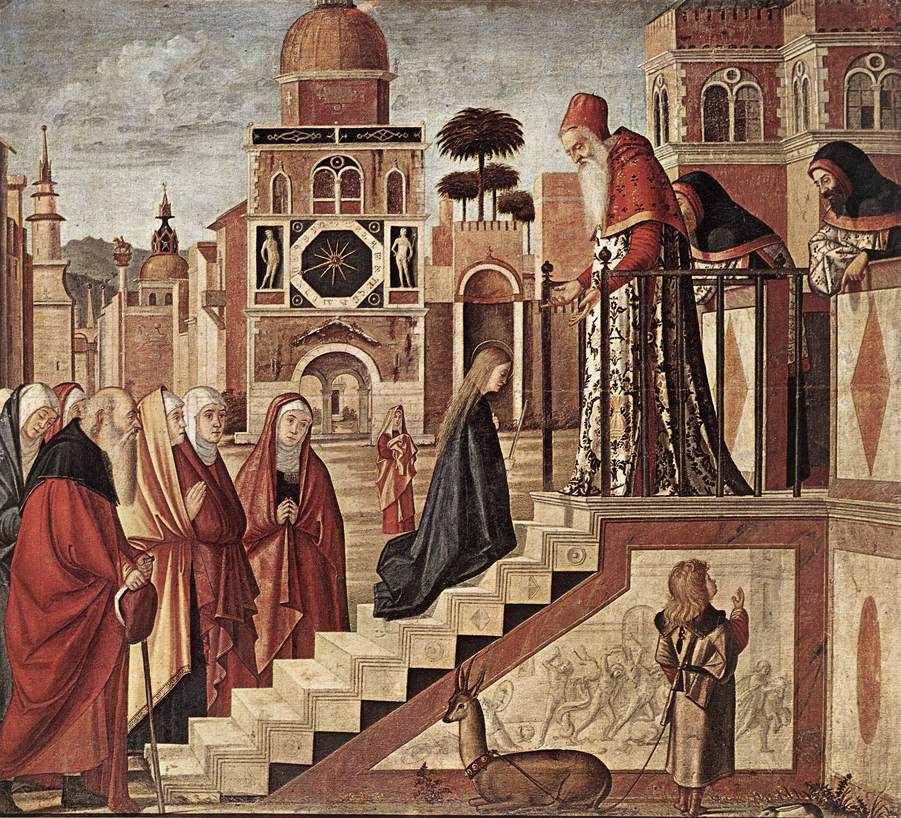Nicholas LUDFORD / The Cardinall's Musick
Missa Videte miraculum · Ave cuius conceptio

medieval.org
AS&V Gaudeamus 131
1993
MISSA VIDETE MIRACULUM
with Plainsong Propers for the Feast of the Purification
01 - Introitus. Suscepimus Deus [4:39]
02 - Kyrie. Deus creator omnium [2:22]
03 - GLORIA [10:15]
04 - Gradualis. Suscepimus Deus [2:22]
05 - Alleluya. Adorabo ad templum [1:41]
06 - Sequencia. Hac clara [2:29]
07 - CREDO [11:21]
08 - Offertorium. Diffusa est gratia [1:45]
09 - SANCTUS · BENEDICTUS [10:43]
10 - AGNUS DEI [6:49]
11 - Communio. Responsa accepit Symeon [0:58]
12 - AVE CUIUS CONCEPTIO [9:23]
13 - Responsorium. Videte miraculum [4:34]
THE CARDINALL'S MUSICK
Andrew Carwood, David Skinner
Sopranos: Carys Lane, Caroline Ashton, Juliet Schiemann, Fiona
Clark, Olive Simpson, Rebecca Outram
Altos: David Gould, Nigel Short, Stephen Taylor
Tenors: Paul Badley, Philip Cave, Simon Berridge, David Jones,
Tom Phillips, Matthew Vine
Baritones: Paul Charrier, Robert Evans, Edward Wickham
Basses: Bruce Hamilton, Robert Macdonald, Michael McCarthy
Producer: David Skinner
Recording Engineer: Martin Haskell
Recorded in: All Saint's Church, Petersham
Design: Studio B, The Creative People
Cover: Vittore Carpaccio (c. 1460/5-1523/6) "Presentation of Mary in
the Temple", Pinacoteca di Brera, Milan/Bridgeman Art Library, London
Photograph: Stuart Bebb

THE WORKS OF NICHOLAS LUDFORD
Volume I
The name of Nicholas Ludford is familiar to most students of English
music. He is generally perceived as a lesser contemporary of Robert
Fayrfax (Ludford's festal masses are preserved with those by Fayrfax in
the great early 16th-century choirbooks at Lambeth Palace, London, and
Caius College, Cambridge), and all that is commonly known of him is
that his music defines the gap between Fayrfax and John Taverner.
However, most are unaware that, with eleven complete and three
incomplete mass settings (with a record of another three which are now
lost), Ludford was the most prolific composer of masses in Tudor
England. He possessed compositional skills equal to any of his
better-known contemporaries, and was indeed one of the greatest
composers for the pre-Reformation church in England. Although a
substantial amount of information concerning Ludford and his music has
circulated this century, until now his music has never been committed
to disc. John Caldwell, in his recently published Oxford History of
English Music, comments that it is "... more a matter of
astonishment that such mastery should be displayed by a composer of
whom virtually nothing was known until modern times". The present
ASV/Cardinall's Musick series will include Ludford's complete festal
masses, each set within its appropriate liturgical framework, and aims
to establish him as one of the last unsung geniuses of Tudor polyphony.
Nothing is known of Ludford's early career. His date of birth is
estimated to be 1485, an assumption which is drawn largely from his
entry into membership of the Fraternity of St Nicholas — a guild
of London parish clerks — in 1521 (Fayrfax was admitted in 1502,
and Taverner in 1514). From after the turn of the century Ludford
became attached to St Stephen's, Westminster, a college of secular
canons adjoining the Royal Palace of Westminster, where he remained
until its dissolution by Henry VIII in 1547. In the dissolution
certificate Ludford is named as 'verger' and was awarded a pension,
receiving payment as late as 1556. It is assumed that he died in 1557.
Forty years later, Thomas Morley mentions Ludford as one of the listed
'authorities' for his famous Introduction to Practical! Musicke
(London, 1597). However, Ludford's music was already forgotten by the
17th century and remained so for 300 years. In the present century two
movements occurred to resurrect Ludford and his music. In 1913, H.B.
Collins presented a paper at the Musical Association which briefly
outlines Ludford along with several other Tudor composers. In response
to Collins's paper, Sir Richard Terry announced the publication of
Ludford's complete masses (his several abridged editions of Ludford's
masses were already being performed by his choir at Westminster
Cathedral). Although Terry was never able to publish his works,
Ludford's name was firmly established in academic circles, and this led
to the compilation of his first biography by W.H.G. Flood in 1925.
Ludford then again fell silent for thirty years until a new wave of
academics attempted to reintroduce him and his music. In 1958 Hugh
Baillie substantially revised and corrected Ludford's biography and
outlined his musical development; a few years later John Bergsagel
fulfilled Terry's promise and published Ludford's complete masses, with
articles on his music. However, Ludford was again set aside and it is
curious that, in their well-founded exhilaration for his
contemporaries, most enthusiasts of Tudor polyphony have overlooked the
fine qualities of his music. With the market for 16th-century polyphony
ever increasing, it remains puzzling that such an extraordinary
musician as Ludford be disregarded for so long.
Reasons for this neglect may stem from the modest circumstances of his
life. Ludford was not well known in his own day and remained
politically and musically inconspicuous throughout his career; he
appears not to have taken a university degree and his name is not
recorded in conjunction with any major events. The few contemporary
references show him to be a retiring personality and deeply religious.
Whereas most composers who survived the English Reformation adapted
their styles to accommodate changing liturgical requirements (such as
Tallis and Sheppard), Ludford apparently stopped composing altogether
after about 1535. It is believed that this was due either to old age
and increasing infirmity or to the fact that his attachment to
Catholicism was such that he could not continue to produce music for
the reformed church.
Perhaps the most striking characteristic of Ludford's music is his
imaginative use of vocal texture, combined with a remarkable quantity,
and quality, of splendid melodies. Missa Videte miraculum, for
six voices, is unusually scored with two equal treble parts throughout.
The work derives its name from the cantus firmus upon which it
is based (Vespers respond, Purification); this migrates from one voice
to another at various points in each movement. The Agnus Dei is unusual
in that as a cantus firmus Ludford employs the respond verse
'Hec speciosum', although the head motif is identical to the other
movements. Ave suius conceptio, for five voices, is one of
Ludford's three votive antiphons which remain reconstructible (all lack
the tenor). A considerably later composition than the mass, its text
survives in numerous printed English prayer books from the early 16th
century. Fayrfax is also known to have set a work (now lost) on the
same text.
A great concern when familiarising oneself with a neglected composer
for the first time is whether or not the music warrants public revival.
Although, academically, some music may look impressive on paper, it is
sometimes the case that the same music in performance can be
disappointing. Ludford has had the sound backing of musicologists for
nearly 100 years, and now awaits the critical ear of the listener.
Perhaps the freshest opinion we can offer is that of the singers on
this recording — in simple yet resounding terms, his music is
"tuneful, electrifying, and memorable".
© 1993 David Skinner
SOURCES
Polyphony:
Missa Videte miraculum
Cambridge University Library, Gonville and Caius MS 667, p32.
Ave cuius conceptio
Cambridge University Library, Peterhouse MSS 471-74; ff. 93, 84v, 104,
80, (Baritone editorially supplied).
Plainsong:
Oxford, Christ Church Library, Graduate secundum morem et
consuetudinem preclare ecclesie Sarum politissimis formulis (ut res
ipsa indicat) in alma Parisiorum Academia impressum, (Paris, 1527).
Antiphonale Sarisburiensis, Partis Hyemalis, (Paris, 1519) f.
43v.
Music edited by David Skinner, and published by The Cardinall's Musick
(Edition)
THE FEAST OF THE PURIFICATION OF OUR LADY
Originally brought from the East by monks fleeing the Moslem invasion
of the Holy Land in the seventh century, the Purification celebrates
three elements described in chapter two of St Luke's Gospel (22-35).
Firstly, that Mary and Joseph, in order to conform to Jewish law as
laid down in Exodus, should present their first-born son to the Temple
to be dedicated to God; secondly, that having borne a child, the mother
was now unclean, disqualified from public worship and therefore in need
of purification through an offering; and thirdly the prophecies of
Simeon and Anna.
In the Eastern rites, the emphasis was on Christ's presentation,
fulfilling the prophecy contained in the Book of Malachi — "...
the Lord whom you seek will suddenly come to his temple" (3:1) —
and allowing the liturgy to reflect the story of Christ's life in
scriptural order. But the emphasis in the West was so centred around
the Virigin that it soon became a Marian feast celebrating her
purification, in spite of a major theological problem. Why was Mary
(who was free from original sin) in need of purification? The answer
was said to lie in Mary's piety and her humble acceptance of religious
law: as it says in Ludford's antiphon Ave cuius conceptio,
"cuius purificatio fuit purgatio" — her "purification was our
expiation".
Simeon's prophecy is enshrined in the Catholic office of Compline and
the Anglican office of Evensong as the Nunc dimittis. It
contains not only the joy of Simeon's fulfilment but also the important
truth that Christ's redemption is not just for the circumcised but for
all — "a light for revelation to the Gentiles" (Luke 2:32).
Simeon goes on to warn of the difficulties of Christ's life and the
piercing of Mary's heart by a sword.
In the main, the texts for the Mass concentrate on elements of the
Presentation. The Introit, Gradual, Alleluya and Communion are all
concerned with waiting for deliverance: the Communion specifically
speaks of Simeon. The Sequence and the Offertory have Mary as their
theme but make no attempt to deal with her purification, celebrating
rather her lack of sin and her importance as the body through which
redemption is made possible.
Liturgically, the feast falling forty days after the Nativity (forty
being a mystical number) is the final feast of the Christmas cycle. It
also has attached to it the title Candlemas which grows out of the
tradition of processing with candles during the singing of antiphons
before the Mass, symbolising Christ as the light of the world and
welcoming his redemption. In spite of a ban by the English Reformers in
1548, it remains a regular part of the Feast's celebrations
© 1993 Andrew Carwood



